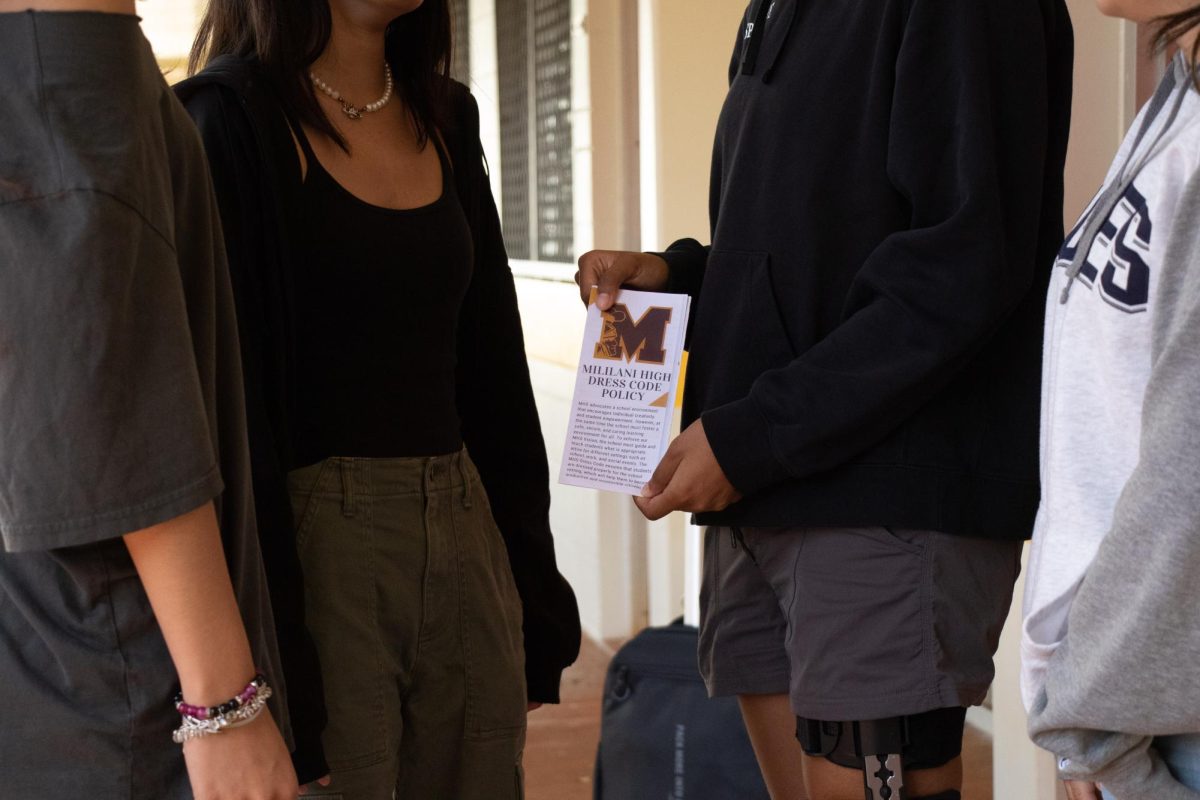Rising Awareness: Vaping, An Emerging Issue
November 12, 2019
As of Nov. 3, about 75 percent of 418 students at MHS know someone who uses a nicotine device and about 91 percent are aware of the recent deaths, health risks and/or injuries that are caused by vaping. Furthermore, about 30 percent of students witness their peers vape five or more times a day, establishing a prevalent problem throughout MHS.
The use of e-cigarettes and the act of vaping was first introduced to the U.S. in 2006. Originally marketed as an alternative to cigarettes, the detrimental health effects are now starting to proliferate 13 years later, alluding similar health effects as its predecessor.
As found by Yale University, vaping devices have not yet been proven to help adult smokers quit smoking and may increase the number of teens using cigarettes in the future. The stigma that nicotine devices are a healthier alternative to cigarettes can be identified as a way to justify the act of vaping. There are also approximately 30 annual vaping conventions in the U.S., which glorify vaping as “cool” or “trendy.”
“I think with the chemicals found in vaping, they’re easily absorbed by the body because it’s in liquid form that can be a part of the circulation system, whereas smoking — yes it can be filtered through the lungs first but it doesn’t mean it will be part of the circulation system,” said AP Biology teacher Nel Venzon, who has a doctorate in education and leadership from the University of Southern California.
With Hawai’i now hopping onto the “trend” of vaping, a total of two illnesses have occurred since Sept. 10. A teenage girl on the Big Island was Hawai’i’s first case. Her health was in critical condition and she was airlifted to Kapi’olani Medical Center for Women & Children on Oahu. These vaping related illnesses have recently been given the name EVALI by the Centers for Disease Control and Prevention (CDC), which is defined as a patient that has a lung injury associated with the use of e-cigarettes or vaping products.
Hawai’i’s Health Department set a Health Advisory on Oct. 7, informing the general public about the risks of vaping and current global findings. This was Hawai’i’s first attempt to lessen the growing vaping problem. “E-cigarettes and vaping products are unsafe and unregulated,” said the Hawai’i State Health Department. “While there are claims that vaping devices help smokers kick their cigarette habits, not enough time has elapsed, nor has testing been done, to verify this claim or the potential for other health impacts.”
Like many other states such as New York, Rhode Island, Michigan and Massachusetts, Hawai’i’s Department of Health has discussed banning vaping altogether, although they ultimately decided against it. With the possibility of becoming heavily regulated, vaping brings the appeal of breaking rules. “Then it becomes something sneaky, fun or black market. So it may even push the issue even more because then you really get unregulated products,” said Dr. Jeremy Creekmore, a psychiatric nurse practitioner at Ho’ola Pono (a private practice) and professor at Chaminade University. Teen Care Supervisor Ellen Fooks added, “Some people get excited by trying to break rules (and) that is not an answer.”
As of Oct. 15, the CDC has recorded that of the 1,364 vaping related illness cases reported, 14 percent are under the age of 18. In terms of classroom size, in a class of 20 students, roughly two students in every class vape. Hawai’i is ranked as the second highest state for vaping among high school students (23 percent) and first for middle school students (13 percent) in the nation. Hawai’i’s population size and demographic may be a prevalent factor. “In Hawai’i things get trendier quicker and go out of style quicker too,” said Fooks.
According to a recent survey at MHS, about 60 percent of students think teens vape to fit in or be cool. “Oahu is in very similar ways like a big city,” said Creekmore. “So we are seeing a lot of the stuff that is going on on the mainland kind of catch up here, and of course we are an interpopulation which would actually skyrocket the act of vaping.”
On Oct. 16, two national tobacco control experts joined more than 100 public health advocates, educators and law enforcement officials for a Menthol and Flavored Tobacco Summit, where they discussed the recent vaping issues in Hawai’i. They decided that vaping should be treated like smoking, which means raising tax prices to be less affordable for children, ban flavors other than tobacco and reduce access through the internet and retail stores.
This also means that Hawai’i doctors and health professionals are accommodating the new health hazards related to vaping. “If someone comes in with a cough (or) any other symptoms, it probably would help to just go deeper, to make sure it is not tied to some other vaping related illness,” said Creekmore.
The term vaping is defined as the act of inhaling and exhaling aerosol or vapor, which is produced by an electronic cigarette. The smoking device comes in many forms and names such as: Mod, Suorin, Pen, Juul, Orion, etc. The liquid that is being vaporized is often called “juice,” which is available in flavors such as Blue Raspberry, Strawberry Lemonade and Banana Bread. This variety of flavors is what draws in the younger audience. “It is like getting a pack of gum, when you think about it. But really when you look at the core of it, it’s still nicotine,” said Creekmore.
With the variety of vaping devices comes many modifications, both to the e-cigarettes and the aerosolized liquid which can be laced with carcinogens, arsenic, cadmium, lead, nickel and the common drug marijuana (containing the chemical tetrahydrocannabinol or THC). The concentration of nicotine can also be modified, such as condensing the amount used. As a result, the U.S. Food and Drug Administration (FDA) and CDC are having a hard time pinpointing the exact chemicals linked to vaping-related illnesses. “The unfortunate thing is that these devices can be modified. So what someone gets from the store is not something they may actually be using,” said Creekmore, “You heard about the exploding and now you have people who are dabbing and aerosolizing THC.”
The first vaping related death was reported on Aug. 23 in Illinois. Since then, multiple vaping related illnesses have spiked all over the United States. “As of Oct. 22, 2019, 1,604 cases of e-cigarette or vaping product use associated lung injury (EVALI) have been reported to CDC from 49 states (all except Alaska), the District of Columbia and one U.S. territory,” said the CDC.
The state of Colorado reported their first vaping related illness on Sept. 9. Piper Johnson, a freshman college student who suffered from a fever and rapid heart rate, became part of the rising vaping related illness statistics. On Sept. 16, the CDC released to the media that the Emergency Operations Center was activated to aid in the investigation of lung injury illnesses to vaping, eventually establishing the term EVALI for vaping related illnesses. “You do get respiratory illnesses like cough, chest pain, but there is also a lot of gastric and intestinal. So like stomach pain, nausea, vomiting, diarrhea,” said Creekmore. “So people aren’t putting two and two together.”
Following the pattern of statistics mentioned, many students at MHS know fellow peers who vape. As shown in a recent survey, about 83 percent care about the recent vaping related illnesses. “So we work indirectly with vaping because the kids that we work with, I would say six out of 10 of the kids we work with also vape,” said Fooks.
High school Teen Care focuses primarily on alcohol and marijuana use. In regards to the middle schools, they focus more on vaping awareness. “We go and do a project alert prevention class with the health classes,” said Fooks. “We do a vaping content thing, a semester at a time.”
As the dangers of vaping become more evident, the next step in addressing the problem would be to raise awareness. Educating students of the detriments can be incorporated into school activities such as assemblies and advisory lessons. “Because there is a lot of money being thrown at it now and there are specialists that would actually come to the school and actually do that for us,” said Fooks. Venzon added, “We should encourage students to know more about it and we should inform everyone — not just the students, but the community members — about the negative adverse effects once you start vaping.”
Parents can also help by becoming aware of the effects of vaping. Educating the youth and openly expressing concerns in regards to vaping, allows children to confide in their parents. Parents should be conscious of the symptoms of an onset vaping related illness, to help possibly identify the illness in their child.
Although adults and parents care about vaping use in the youth, it is the younger generations’ concerns and opinions that will create a change. There are many ways for the youth to get involved, either through social media, caring or awareness. “Adults caring can help to a certain point, but when you guys start caring and if it’s not cool to vape, it starts a new kind of phenomenon,” said Fooks.
It is common for those who vape to avoid confrontation. However, if a student vapes and is seeking help or knows of someone who does, there is assistance available on the MHS campus. Teen Care, which is open during lunch, recess and after school is an accessible option for help on campus. Counselors are also available outlets for teens looking to talk. “You know the school counselors here are just amazing and they are not going to rush to tell the parent that you are smoking and vaping a lot,” said Fooks.
If you vape and are experiencing symptoms including coughing, shortness of breath, chest pain, nausea, vomiting, diarrhea, fatigue, fever or abdominal pain, seek medical attention. You may also call the Hawai’i Poison Hotline at 1-800-222-1222, available 24 hours a day, seven days a week.



